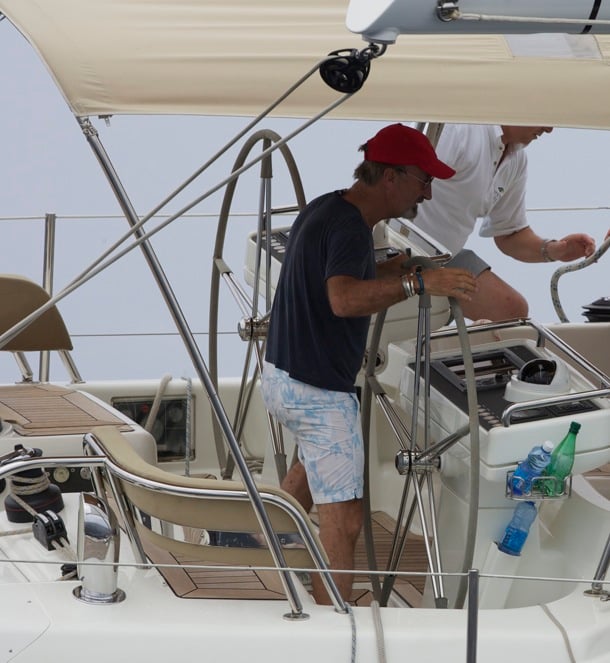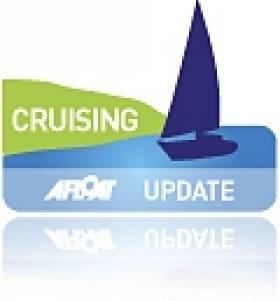Displaying items by tag: Oyster
Eddie Jordan Racing...On Water
Irish F1analyst Eddie Jordan might be better known for exploits on tarmac than the high seas but it did not stop the 63-year old Dubliner sailing a smart race to win in the south-eastern Caribbean Sea today in day one of the Oyster Regatta writes Louay Habib. But the F1 man's powerful Oyster 655, Lush was pushed all the way by Chris Shea's Oyster 72, Magrathea.

Eddie Jordan at the helm of the Oyster 655, Lush. Photo: Ingrid Abery
Grenada's lush, green paradise relies on rain and on the morning of Lewmar Race Day, the Oyster Fleet certainly got that. But despite the torrential downpour, the mood in Port Louis was up beat and all of the fleet left the dock, to perform a parade of sail, before heading out to the race area.
As if by magic, shortly after the start an easterly wind blew away the rain clouds. Providing dry, if somewhat tricky conditions. During the course of the day, there were numerous wind shifts, predicting these changes was the secret to success. A light airs start was followed by a building breeze, which piped up to fifteen knots by the end of the race.
Starts are always important but especially in fickle breeze and the Polish Oyster 46, SunsuSea, judged the line to perfection, to get away well. Owned by Mariusz and Paulina Kierebinscy, SunsuSea came to the Caribbean in the 2009 ARC.
"We have been really delighted with the boat." Smiled Mariusz. "My family love to sail, especially in the Caribbean. This is our second Oyster Regatta and although we have little experience with racing, it is a great way to learn how to improve our sailing technique."
Besides Mariusz and Paulina, SunsuSea is crewed by their family and friends. Daughter Claudia and son Martin are fast learners in the cockpit. Whilst friends, Artur and Margaret trim the mainsail, helped by their daughter Adriana, who is just 11 years of age.
"We really like Grenada." Continued Mariusz. 'It is such a friendly place and safe for our children. After the regatta, we will be cruising through The Grenadines to St. Lucia, our last adventure before the boat returns across the Atlantic."
In Class One, Lush, with F1 racing analyst, Eddie Jordan on board, sailed a smart race to win, but the powerful Oyster 655 was pushed all the way by Chris Shea's Oyster 72, Magrathea, who sailed a near perfect beat by using the lifting breeze, along Grande Anse Beach. Jonathon and Jane Mould's Oyster 72, Koluka claimed a well-deserved third in class.
Alan Brook, taking part in his first Oyster regatta as a competitor with his wife Sue in their Oyster 56, Sulana, won the first race in Class Two, the meticulously prepared yacht was extremely well positioned on the racecourse to win by a fair margin. Scott Bickford's American Oyster 53, Contingency was second and Ian Galbraith and crew, racing his Oyster 53, Jigsaw, kept their concentration to take third.
After the fleet had returned to the safe confines of Port Louis Marina, a cocktail party, hosted by the Marine and Yachting Association of Grenada, was full of talk about the day's events.
Later that evening, the Oyster family was treated to a lavish party at the exclusive LaLuna Estate. Tucked away south of the capital, LaLuna is the hidden gem of Morne Rouge Bay, which offers one of the finest beaches on the island, just minutes from St George's. The estate is often frequented by stars of the stage and film and provided a truly magical occasion for the second Oyster party of the regatta.
The ultra-chic secluded venue has a rustic charm extenuated by the use of traditional Caribbean materials to provide a design-fusion, which is unmistakably Asian in appearance. The wooden beachfront courtyard blends cane, cotton, and thatch and inviting day beds are scattered throughout the resort with sublime views of the perfect beach.
The Oyster family enjoyed a mouth watering four-course dinner with fine wine in a wonderful atmosphere. Afterwards, a company of dancers electrified the atmosphere and very soon the party was a very lively affair. It may have been a day of mixed fortunes on the water but the Oyster crew-conga, snaking through the LaLuna's courtyard, was testament to a very successful first day's racing at the Oyster Regatta in Grenada.
Racing resumes on Wednesday 13th April with a coastal race sponsored by Pelagos Yachts, finishing at Le Phare Bleu Marina, on the south coast of Grenada, where the fleet will overnight.
Historic Trophy for South Pacific Dream Cruise
Fergus and Kay Quinlan live in the Burren in County Clare, and in 1997 they launched the steel van de Stadt 12-metre cruiser Pylades, which they'd built themselves. They've made several voyages and have been in the Irish Cruising Club's award list before. But at the ICC's AGM in the National YC on February 18th they deservedly got the big one, the Faulkner Cup, for the first stage of a global circumnavigation which began from their home port of Kinvara in the summer of 2009, and a year later they'd reached Tahiti.
Their cruise continues, so the award was made in absentia. Adjudicator Brian Cudmore of Cork made the point that their informative log included much general and often entertaining information, and it becomes even more interesting the further you got into it, so he's keenly anticipating the next inmstalment.
The Strangford Cup for an alternative best cruise could not have been more different, both in location or boat type. The 44ft Young Larry may have been built of steel in 1995, but she was based fairly precisely on the design of a gaff cutter built in 1907. And though the rig has been made more manageable through being a yawl, even the mizzen is gaff-headed, while the main sets a topsail. Not the most-easily handled rig for challenging seas, you might well think, but Maire Breathnach (originally from Dungarvan) and her partner Andrew Wilkes, crewed by Maire's niece Sibeal Turraoin, took Larry Og – which looks for all the world like a smaller Asgard I – right through the Northwest Passage to Alaska, an extraordinary one-season achievement.
The ICC members logged some other notable Atlantic voyages, with Michael Coleman of Cobh, a Port of Cork Pilot before he got the free bus pass, making a fine Atlantic triangle to the Azores, then Newfoundland, and so home to Cork, visiting many islands with his well-found 1988 Oyster 53 Oyster Cove. It was all done with a crew of average age 66, senior member Tom Noonan aged 76, and worthy winners of the Atlantic Trophy.
Over the years since its foundation in 1929, the Irish Cruising Club has become the trustee and adjudicator of many trophies, twenty in all, and two of them were special presentations in 2010. The Donegan Memorial Trophy went to Ruth Heard, an ICC member since 1967. She has cruised both to the Azores and Iceland, but is honoured this year in celebration of her remarkable contribution to the rebirth of the inland waterways, and to mark the re-opening of the Royal Canal. Ruth Heard was on the crew of Harklow, the last boat to transit the Royal in 1954 before its half century of official closure which was gloriously reversed in 2010.
And once upon a time, the ICC was the organiser of Ireland's Admiral's Cup campaigns. Though many members still race offshore as individuals, the club has long since focused totally on cruising. But it has a general trophy, the John B Kearney Cup for Services to Irish Sailing, and for 2010 it was awarded with acclamation to the successful Irish Commodore's Cup Team.
- Faulkner
- Cruise
- Cruising
- Cup
- Club
- Quinlan
- Kay
- Fergus
- ICC
- National
- yacht
- cub
- YC
- Cudmore
- Cork
- Breathnach
- Alaska
- Asgard I
- Strangford
- Burren
- Pylades
- Northwest
- Passage
- Wilkes
- Sibeal Turraoin
- Coleman
- Atlantic
- Cobh
- Newfoundland
- Oyster Cove
- Oyster
- Donegan
- trophy
- Ruth Heard
- John B Kearney
- Cup
- Commodore's
- gaff






























































